Crestron Electronics TSW-1060 10.1-inch Touch Screen User Manual
Crestron Electronics Inc 10.1-inch Touch Screen Users Manual
Users Manual
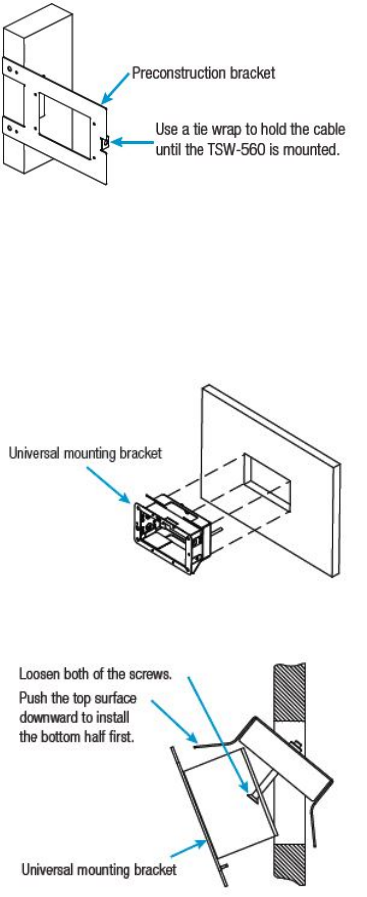
TSW-560/TSW-760/TSW-1060
5-Inch, 7-Inch, and 10.1-Inch Touch Screens
DO Install the TSW-560 Mounting Bracket
The Crestron® TSW-560 can be mounted into drywall and other surfaces, or it can be mounted onto a
wall stud. When mounted into drywall and other surfaces, the touch screen protrudes 1/2" (13 mm)
from the mounting surface.
To mount the TSW-560, use the following procedure:
1. For preconstruction applications, use standard drywall nails or screws to attach the included
preconstruction mounting bracket to a wall stud.
CAUTION: Allow an air gap of at least 12" (305 mm) in the wall cavity above and below the TSW-560 for
heat dissipation.
For postconstruction applications, use the preconstruction bracket as a cutout template by turning the
bracket to face the wall, ensuring it is level, and temporarily tacking it to the wall with finishing nails (not
included) in the smaller holes around the cutout opening. Trace the cutout opening with an appropriate
drywall saw (not included).
2. Loosen the two screws on the included universal mounting bracket, and then install the
universal mounting bracket bottom first into the opening.
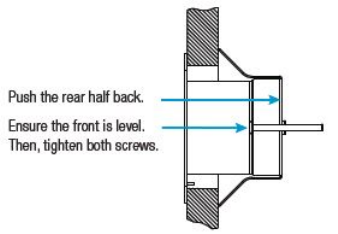
3. Reach into the universal mounting bracket and push the rear half back to ensure it is fully
behind the mounting surface. Ensure the front of the universal mounting bracket is level. Then,
tighten the two screws to complete the installation.
CAUTION: To avoid damage to the bracket, do not overtighten the screws.
Qty
Product
Color
Part Number
Items for TSW-560 Only
1
Latch, Security
4525305
1
Bracket, Universal Mounting
4525127
1
Bracket, Pre-Construction
4524592
Items for TSW-760 and TSW-1060 Only
1
Bracket, Mounting
4525352
1
Latch, Security
4525305
4
Screw, 6-32 x 3/4", Undercut Head, Phillips
2033247
4
Screw, M3 x 16 mm, Flat Head, Phillips
2013788
DO Install the TSW-760 or TSW-1060 Mounting Bracket
The Crestron TSW-760 and TSW-1060 install over a standard 2-gang or 3-gang U.S. electrical box, a 2-
gang European electrical box, or a 2-gang U.K. electrical box. The touch screens can also be attached
directly to drywall and other surfaces over the front of a 2-3/8" (60 mm) high by 3-3/8" (86 mm) wide
cutout. When installed, the touch screen protrudes 1/2" (13 mm) from the mounting surface,
eliminating any visible screws.
To mount the TSW-760 or TSW-1060 into an electrical box, use four of the eight included screws (four 6-
32 x 3/4" or four M3 x 16 mm screws) to attach the mounting bracket to the electrical box, as shown in
the following illustrations.
NOTE: For U.S.-style installations, use a #2 Philliips screwdriver. For European-style installations, use a
#1 Phillips screwdriver or equivalent.
For U.S.-style installations, use the 6-32 x 3/4" screws.
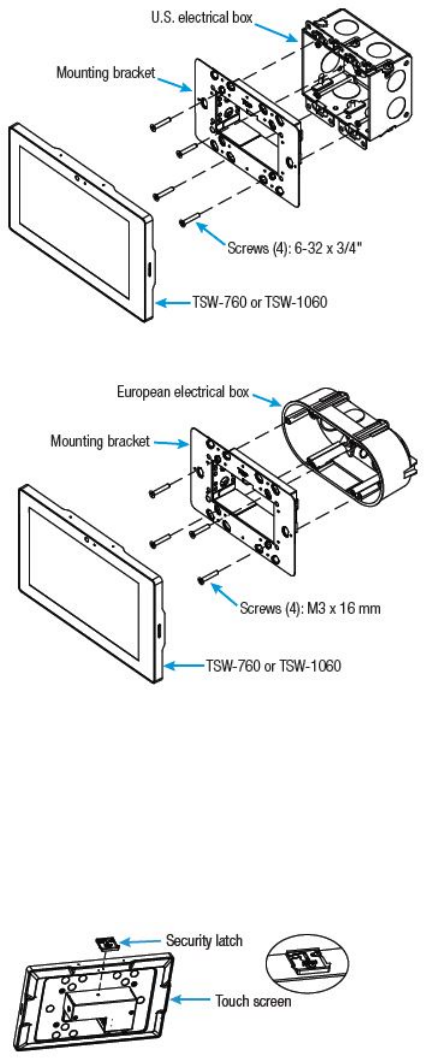
For European-style installations, use the M3 x 16 mm screws.
To complete the installation, refer to “DO Complete the Installation” on the next page.
DO Install the Touch Screen Security Latch (Optional)
The touch screen comes with a security latch, which can be installed so that the touch screen cannot be
easily removed from the mounting bracket after installation.
To install the security latch, use a small Phillips screwdriver to screw the security latch to the top of the
touch screen’s rear housing before the touch screen has been inserted into the mounting bracket.
To remove the touch screen after the installation is complete, pull the touch screen away from the wall
until the security latch makes contact with the mounting bracket. Then, insert a flathead screwdriver
into the slot on the security latch and rotate the latch into the open position, which causes the security
latch arms to retract. While the arms are retracted, pull on the touch screen to disengage it from the
mounting bracket.
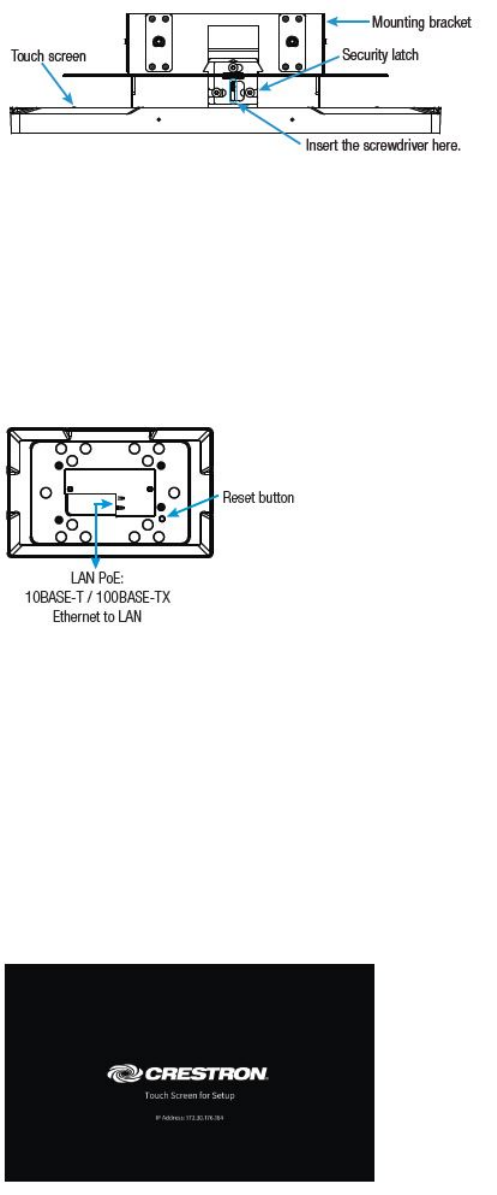
NOTE: There is a small amount of “play” in the bracket mounting, which allows room for the
screwdriver.
DO Complete the Installation
Make connections to the touch screen using Crestron power supplies for Crestron equipment. Power
and data connection to the touch screen is provided by a single Ethernet cable connected to the LAN
port on the rear of the unit. A Crestron PoE (Power over Ethernet) power supply or PoE-capable network
switch is recommended (both sold separately). Apply power after the Ethernet cable is connected.
Once all connections to the device have been made, carefully hold the touch screen over the mounting
bracket and gently place it in position.
NOTE: If the touch screen is not level after installation, pull the touch screen out of the mounting
bracket and slightly loosen the screws holding the bracket into place. This procedure allows the
mounting bracket to be slightly rotated. Once the touch screen has been repositioned, retighten the
screws, reinstall the touch screen into the bracket, and ensure that the touch screen is now level.
DO Access the Setup Screen
NOTE: The touch screen can take up to 120 seconds to boot. When power is applied for the first time,
the following screen appears.
Tap Enter Setup to display the main Setup screen.
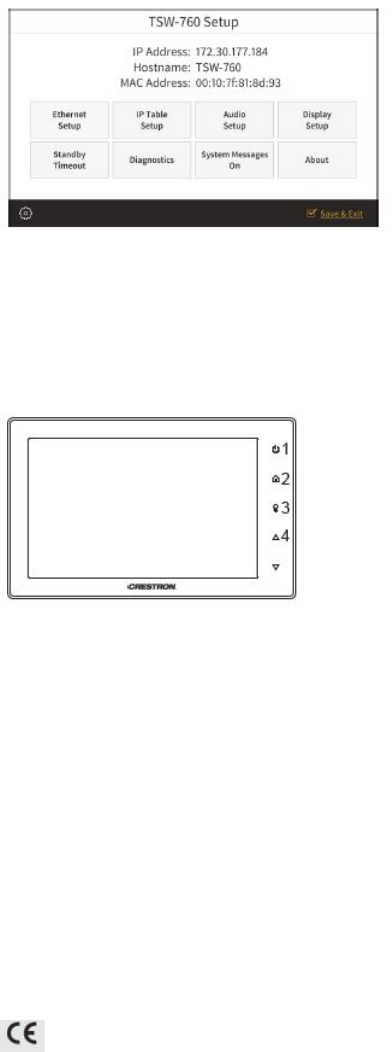
NOTE: During regular operation of the touch screen, there are two ways to activate the setup functions:
• Place a button on the project main page and assign the reserved join number (17242) that
activates setup.
• Touch the hard keys labeled below as 1, 2, 3, and 4 in sequence twice (touch 1, 2, 3, 4, 1, 2, 3, 4)
within a 5-second period.
DO Configure the Device
Use the setup screens to configure various settings for the touch screen, including Ethernet setup, IP
table setup, audio setup, display setup, standby timeout, and diagnostics. For more information on
configuring the touch screen, refer to the TSW-560, TSW-760, and TSW-1060 Supplemental Guide (Doc.
7927) at www.crestron.com/manuals.
DO Learn More
Visit the website for additional information and the latest firmware updates. To learn more about these
products, use a QR reader application on your mobile device to scan the QR images.
Crestron Electronics
15 Volvo Drive, Rockleigh, NJ 07647 888.CRESTRON | www.crestron.com
As of the date of manufacture, the product has been tested and found to comply with
specifications for CE marking.
Federal Communications Commission (FCC) Compliance Statement
This device complies with part 15 of the FCC Rules. Operation is subject to the following two conditions:
(1) This device may not cause harmful interference, and (2) this device must accept any interference
received, including interference that may cause undesired operation.
CAUTION: Changes or modifications not expressly approved by the manufacturer responsible for
compliance could void the user’s authority to operate the equipment.
NOTE: This equipment has been tested and found to comply with the limits for a Class B digital device,
pursuant to part 15 of the FCC Rules. These limits are designed to provide reasonable protection against
harmful interference in a residential installation. This equipment generates, uses and can radiate radio
frequency energy and, if not installed and used in accordance with the instructions, may cause harmful
interference to radio communications. However, there is no guarantee that interference will not occur
in a particular installation.
If this equipment does cause harmful interference to radio or television reception, which can be
determined by turning the equipment off and on, the user is encouraged to try to correct the
interference by one or more of the following measures:
Reorient or relocate the receiving antenna.
Increase the separation between the equipment and receiver.
Connect the equipment into an outlet on a circuit different from that to which the receiver is connected.
Consult the dealer or an experienced radio/TV technician for help.
Industry Canada (IC) Compliance Statement
CAN ICES-3(B)/NMB-3(B)
This device complies with Industry Canada’s licence-exempt RSSs. Operation is subject to the following
two conditions: (1) this device may not cause interference, and (2) this device must accept any
interference, including interference that may cause undesired operation of the device.
Le présent appareil est conforme aux CNR d'Industrie Canada applicables aux appareils radio exempts de
licence. L'exploitation est autorisée aux deux conditions suivantes : (1) l'appareil ne doit pas produire de
brouillage, et (2) l'utilisateur de l'appareil doit accepter tout brouillage radioélectrique subi, même si le
brouillage est susceptible d'en compromettre le fonctionnement.
The device meets the exemption from the routine evaluation limits in section 2.5 of RSS 102 and
compliance with RSS-102 RF exposure, users can obtain Canadian information on RF exposure and
compliance.
Le dispositif rencontre l'exemption des limites courantes d'évaluation dans la section 2.5 de RSS 102 et
la conformité à l'exposition de RSS-102 rf, utilisateurs peut obtenir l'information canadienne sur
l'exposition et la conformité de rf.
This transmitter must not be co-located or operating in conjunction with any other antenna or
transmitter. This equipment should be installed and operated with a minimum distance of 20
centimeters between the radiator and your body.
Cet émetteur ne doit pas être Co-placé ou ne fonctionnant en même temps qu'aucune autre antenne ou
émetteur. Cet équipement devrait être installé et actionné avec une distance minimum de 20
centimètres entre le radiateur et votre corps
Power Rating: 36 - 57 Vdc, 507 - 329 mA
Crestron product development software is licensed to Crestron dealers and Crestron Service Providers
(CSPs) under a limited non-exclusive, non-transferable Software Development Tools License Agreement.
Crestron product operating system software is licensed to Crestron dealers, CSPs, and end-users under a
separate End-User License Agreement. Both of these Agreements can be found on the Crestron website
at www.crestron.com/legal/software_license_agreement.
The specific patents that cover Crestron products are listed at http://www.crestron.com/legal/patents.
The product warranty can be found at www.crestron.com/warranty. Certain Crestron products contain
open source software. For specific information, please visit www.crestron.com/opensource.
Crestron and the Crestron logo are either trademarks or registered trademarks of Crestron Electronics,
Inc., in the United States and/or other countries. Other trademarks, registered trademarks, and trade
names may be used in this document to refer to either the entities claiming the marks and names or
their products. Crestron disclaims any proprietary interest in the marks and names of others. Crestron is
not responsible for errors in typography or photography.
This document was written by the Technical Publications department at Crestron.
©2016 Crestron Electronics, Inc.